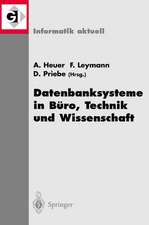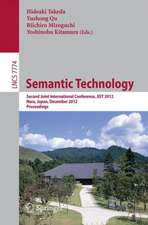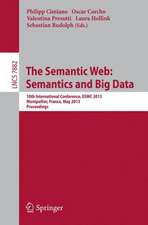Enterprise Information Systems Engineering: The MERODE Approach: The Enterprise Engineering Series
Autor Monique Snoecken Limba Engleză Hardback – oct 2014
A first distinguishing feature is the method’s grounding in process algebra provides clear criteria and practical support for model quality. Second, the use of the concept of business events provides a deep integration between structural and behavioral aspects. The clear and intuitive semantics easily extend to application integration (COTS software and Web Services).
Students and practitioners are the book’s main target audience, as both groups will benefit from its practical advice on how to create complete models which combine structural and behavioral views of a system-to-be and which can readily be transformed into code, and on how to evaluate the quality of those models. In addition, researchers in the area of conceptual or enterprise modelling will find a concise overview of the main findings related to the MERODE project.
The work is complemented by a wealth of extra material on the author’s web page at KU Leuven, including a free CASE tool with code generator, a collection of cases with solutions, and a set of domain modelling patterns that have been developed on the basis of the method’s use in industry and government.
| Toate formatele și edițiile | Preț | Express |
|---|---|---|
| Paperback (1) | 389.63 lei 6-8 săpt. | |
| Springer International Publishing – 23 aug 2016 | 389.63 lei 6-8 săpt. | |
| Hardback (1) | 538.22 lei 6-8 săpt. | |
| Springer International Publishing – oct 2014 | 538.22 lei 6-8 săpt. |
Din seria The Enterprise Engineering Series
- 20%
 Preț: 415.47 lei
Preț: 415.47 lei - 20%
 Preț: 376.03 lei
Preț: 376.03 lei -
 Preț: 398.41 lei
Preț: 398.41 lei -
 Preț: 447.03 lei
Preț: 447.03 lei - 15%
 Preț: 580.36 lei
Preț: 580.36 lei - 15%
 Preț: 485.28 lei
Preț: 485.28 lei - 18%
 Preț: 941.17 lei
Preț: 941.17 lei - 20%
 Preț: 440.25 lei
Preț: 440.25 lei - 20%
 Preț: 395.70 lei
Preț: 395.70 lei - 20%
 Preț: 456.12 lei
Preț: 456.12 lei - 20%
 Preț: 553.06 lei
Preț: 553.06 lei - 20%
 Preț: 601.92 lei
Preț: 601.92 lei - 20%
 Preț: 879.50 lei
Preț: 879.50 lei - 20%
 Preț: 363.00 lei
Preț: 363.00 lei - 20%
 Preț: 358.52 lei
Preț: 358.52 lei -
 Preț: 347.62 lei
Preț: 347.62 lei - 18%
 Preț: 1117.34 lei
Preț: 1117.34 lei - 20%
 Preț: 1288.76 lei
Preț: 1288.76 lei
Preț: 538.22 lei
Preț vechi: 672.78 lei
-20% Nou
Puncte Express: 807
Preț estimativ în valută:
102.98€ • 107.54$ • 85.04£
102.98€ • 107.54$ • 85.04£
Carte tipărită la comandă
Livrare economică 15-29 aprilie
Preluare comenzi: 021 569.72.76
Specificații
ISBN-13: 9783319101446
ISBN-10: 3319101447
Pagini: 250
Ilustrații: XX, 280 p. 178 illus., 27 illus. in color.
Dimensiuni: 155 x 235 x 22 mm
Greutate: 0.6 kg
Ediția:2014
Editura: Springer International Publishing
Colecția Springer
Seria The Enterprise Engineering Series
Locul publicării:Cham, Switzerland
ISBN-10: 3319101447
Pagini: 250
Ilustrații: XX, 280 p. 178 illus., 27 illus. in color.
Dimensiuni: 155 x 235 x 22 mm
Greutate: 0.6 kg
Ediția:2014
Editura: Springer International Publishing
Colecția Springer
Seria The Enterprise Engineering Series
Locul publicării:Cham, Switzerland
Public țintă
GraduateCuprins
Chapter 1. Enterprise Modelling.- Chapter 2. From demand to supply: layers & model quality.- Chapter 3. Overview of MERODE.- Chapter 4. The existence dependency graph.- Chapter 5. Object interaction.- Chapter 6. Object and system behaviour.- Chapter 7. Attributes and constraints.- Chapter 8. Inheritance.- Chapter 9. The information system service layer.- Chapter 10. Bridging business process modelling and domain modelling.- Chapter 11. Model transformation.- Chapter 12. Application and component integration.
Notă biografică
Monique Snoeck is full professor at the KU Leuven, Research Center for Management Informatics (LIRIS), and visiting professor at the U Namur. Her research focuses on enterprise modeling, requirements engineering, model-driven engineering and business process management. Her main guiding research themes are the integration of different modelling approaches into a comprehensive approach, the quality of models through formal grounding, model to code transformations and educational aspects of conceptual modelling. She has published over 80 peer-reviewed papers.
Textul de pe ultima copertă
The increasing penetration of IT in organizations calls for an integrative perspective on enterprises and their supporting information systems. MERODE offers an intuitive and practical approach to enterprise modelling and using these models as core for building enterprise information systems. From a business analyst perspective, benefits of the approach are its simplicity and the possibility to evaluate the consequences of modeling choices through fast prototyping, without requiring any technical experience. The focus on domain modelling ensures the development of a common language for talking about essential business concepts and of a shared understanding of business rules. On the construction side, experienced benefits of the approach are a clear separation between specification and implementation, more generic and future-proof systems, and an improved insight in the cost of changes.
A first distinguishing feature is the method’s grounding in process algebra provides clear criteria and practical support for model quality. Second, the use of the concept of business events provides a deep integration between structural and behavioral aspects. The clear and intuitive semantics easily extend to application integration (COTS software and Web Services).
Students and practitioners are the book’s main target audience, as both groups will benefit from its practical advice on how to create complete models which combine structural and behavioral views of a system-to-be and which can readily be transformed into code, and on how to evaluate the quality of those models. In addition, researchers in the area of conceptual or enterprise modelling will find a concise overview of the main findings related to the MERODE project.
The work is complemented by a wealth of extra material on the author’s web page at KU Leuven, including a free CASE tool with code generator, a collection of cases with solutions, and a set of domain modelling patterns that have been developed on the basis of the method’s use in industry and government.
A first distinguishing feature is the method’s grounding in process algebra provides clear criteria and practical support for model quality. Second, the use of the concept of business events provides a deep integration between structural and behavioral aspects. The clear and intuitive semantics easily extend to application integration (COTS software and Web Services).
Students and practitioners are the book’s main target audience, as both groups will benefit from its practical advice on how to create complete models which combine structural and behavioral views of a system-to-be and which can readily be transformed into code, and on how to evaluate the quality of those models. In addition, researchers in the area of conceptual or enterprise modelling will find a concise overview of the main findings related to the MERODE project.
The work is complemented by a wealth of extra material on the author’s web page at KU Leuven, including a free CASE tool with code generator, a collection of cases with solutions, and a set of domain modelling patterns that have been developed on the basis of the method’s use in industry and government.
Caracteristici
Presents MERODE, a proven methodology exploiting model-driven engineering in enterprise systems engineering Combines easily accessible intuitive concepts with a (hidden) formal underpinning integrating structural and behavioral aspects Includes practical advice on how to create enterprise models that provide the essential architecture of the supporting information systems Applicable to both green field development and application integration Complemented by a wealth of extra material on the author’s web page Includes supplementary material: sn.pub/extras














